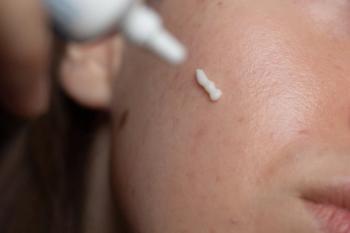
Roflumilast Foam 0.3% Demonstrates Favorable Pigmentation Profile in Seborrheic Dermatitis
Key Takeaways
- The STRATUM trial confirmed roflumilast foam 0.3% efficacy in seborrheic dermatitis, showing significant improvement by week 2 and sustained results through week 8.
- Roflumilast foam was well tolerated, with low treatment-emergent adverse events and rare discontinuations due to adverse events.
At SDPA 2025, a poster evaluating the STRATUM trial showed roflumilast foam 0.3% effectively treats seborrheic dermatitis with minimal pigment changes.
Presented at the 2025 Society of Dermatology Physician Associates (SDPA) Summer Dermatology Conference, a poster1 highlighted results from the pivotal phase 3 STRATUM trial (NCT04973228)2 examining the safety, pigmentation outcomes, and efficacy of roflumilast foam 0.3% (Zoryve; Arcutis Biotherapeutics, Inc) in patients with seborrheic dermatitis.
Led by Andrew Alexis, MD, MPH, and a team of clinical investigators, the trial built on earlier findings supporting the therapy's 2023 approval from the FDA3 by assessing not only clinical clearance but also the impact of treatment on pigmentary changes, particularly in patients with skin of color. Prior safety data from a long-term phase 2 trial suggested that pigmentation abnormalities often resolved over time with treatment, prompting further investigation in the STRATUM trial.
STRATUM enrolled 457 patients aged 9 years and older with at least moderate seborrheic dermatitis affecting the scalp and/or nonscalp areas. Participants were randomly assigned in a 2:1 ratio to receive either roflumilast foam 0.3% (n = 304) or vehicle foam (n = 153), applied once daily for 8 weeks.
At week 8, significantly more patients treated with roflumilast achieved Investigator Global Assessment success compared with vehicle. Superior outcomes for roflumilast were also seen as early as week 2 and continued through week 4.
Furthermore, roflumilast foam 0.3% was well tolerated. Any reported treatment-emergent adverse events (AEs) occurred in 23.0% of roflumilast-treated patients vs 21.6% in the vehicle group. Treatment-related AEs were infrequent (2.6% vs 3.3%). Only 1 serious AE was reported in the roflumilast group (keratoacanthoma), which was deemed unrelated. Discontinuations due to AEs were rare, occurring in 0.7% (roflumilast) and 2.0% (vehicle) of patients.
Commonly reported AEs included COVID-19 (3.6% in roflumilast group vs 3.3% in vehicle), nausea (1.6% in roflumilast group vs 0% in vehicle), and urinary tract infection or nasopharyngitis, each of which occurred in more than 1% of patients.
Although dyspigmentation was uncommon overall, the study paid particular attention to this end point due to its clinical relevance.
Hypopigmentation at baseline was observed in 4.2% (19/457) of patients. It was more common in non-White patients (9.9%) compared with White patients (2.5%). Of 17 evaluable patients with baseline hypopigmentation, 64.7% achieved full resolution by week 8.
Hyperpigmentation was present at baseline in 3.5% (16/457) of patients. Again, it was observably more common in non-White patients (9.9%) vs White patients (1.7%). Of 13 evaluable patients, 46.2% had full resolution at week 8.
At the end of the 8-week treatment period, 98.3% of patients with hypopigmentation showed either no change or improvement, and 99.5% of patients with hyperpigmentation showed no change or improvement.
Only 7 new pigmentary events occurred during the trial, including 1 new case of hypopigmentation (White patient) and 6 cases of hyperpigmentation (4 White, 2 Black or African American).
These findings complement prior long-term safety data supporting roflumilast foam 0.3% as a reliable treatment option for seborrheic dermatitis, with the potential to improve both visible symptoms and related pigmentary concerns over time.
References
- Alexis AF, Blauvelt A, Forman SB, et al. Safety and pigmentation changes from a phase 3 trial of roflumilast foam 0.3% in patients with seborrheic dermatitis (STRATUM). Poster presented at: 2025 SDPA Summer Dermatology Conference; June 25-29, 2025; Washington, DC.
- Trial of PDE4 inhibition with roflumilast (ARQ-154) foam 0.3% for the management of seborrheic dermatitis (STRATUM). ClinicalTrials.gov. Updated March 12, 2024. Accessed June 29, 2025.
https://clinicaltrials.gov/study/NCT04973228 - FDA approves Arcutis’ Zoryve (roflumilast) topical foam, 0.3% for the treatment of seborrheic dermatitis in individuals aged 9 years and older. News release. Arcutis Biotherapeutics. December 15, 2023. Accessed June 29, 2025.
https://www.arcutis.com/fda-approves-arcutis-zoryve-roflumilast-topical-foam-0-3-for-the-treatment-of-seborrheic-dermatitis-in-individuals-aged-9-years-and-older/
Make sure to keep up to date with the latest coverage from the conference and subscribe to Dermatology Times to receive daily email updates .
Newsletter
Like what you’re reading? Subscribe to Dermatology Times for weekly updates on therapies, innovations, and real-world practice tips.


















